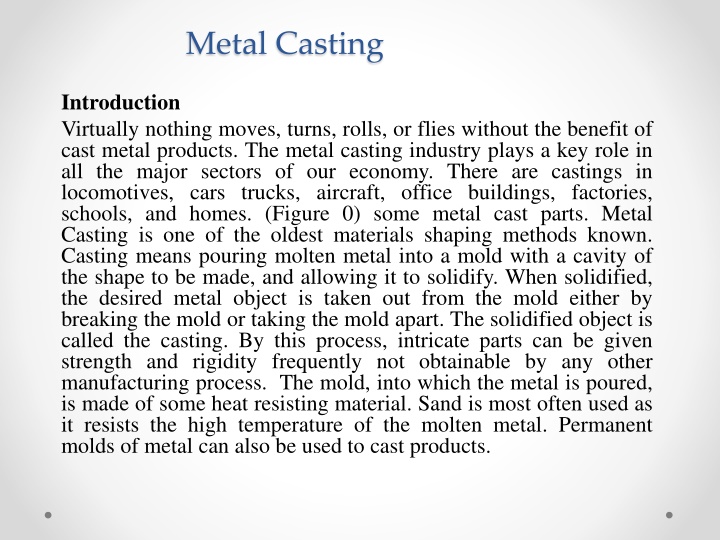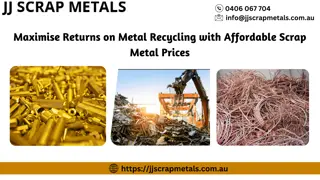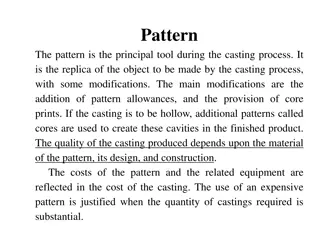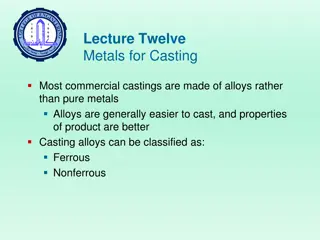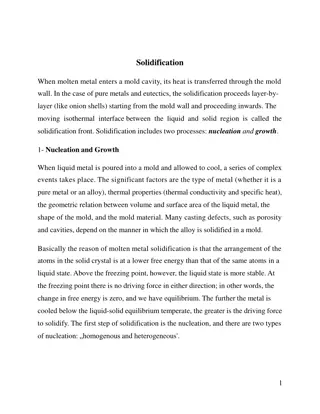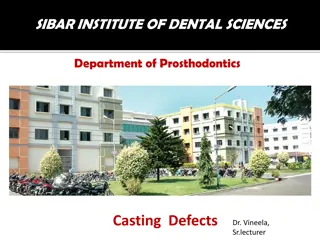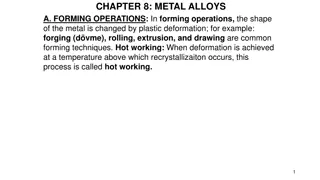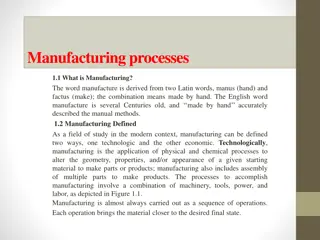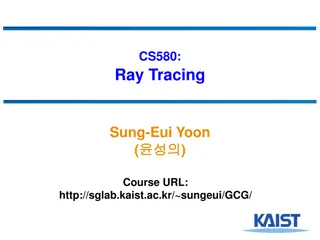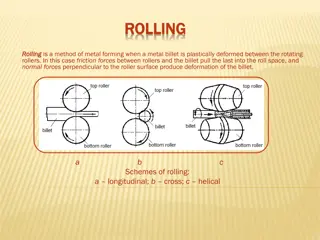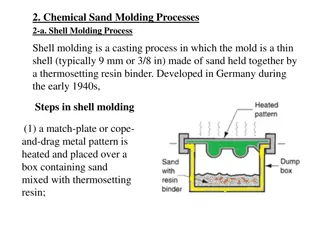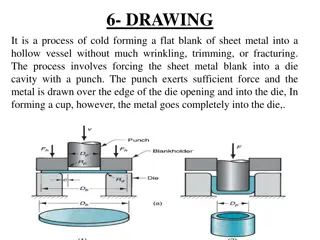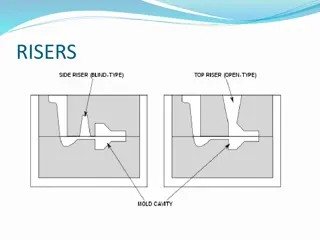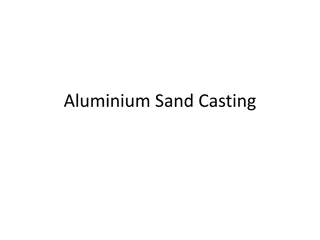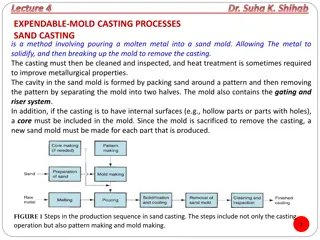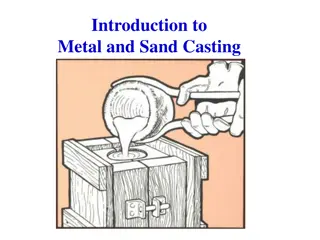Metal Casting: Ancient Manufacturing Technique
Metal casting is a fundamental process that shapes various products by pouring molten metal into molds. This method allows for the creation of intricate shapes and ensures strength and rigidity. While it offers advantages like versatility in materials and weight savings, limitations such as dimensional accuracy are addressed by newer casting processes. Key terms like flask, pattern, and parting line are essential to understanding this age-old technique.
Download Presentation

Please find below an Image/Link to download the presentation.
The content on the website is provided AS IS for your information and personal use only. It may not be sold, licensed, or shared on other websites without obtaining consent from the author.If you encounter any issues during the download, it is possible that the publisher has removed the file from their server.
You are allowed to download the files provided on this website for personal or commercial use, subject to the condition that they are used lawfully. All files are the property of their respective owners.
The content on the website is provided AS IS for your information and personal use only. It may not be sold, licensed, or shared on other websites without obtaining consent from the author.
E N D
Presentation Transcript
Metal Casting Introduction Virtually nothing moves, turns, rolls, or flies without the benefit of cast metal products. The metal casting industry plays a key role in all the major sectors of our economy. There are castings in locomotives, cars trucks, aircraft, office buildings, factories, schools, and homes. (Figure 0) some metal cast parts. Metal Casting is one of the oldest materials shaping methods known. Casting means pouring molten metal into a mold with a cavity of the shape to be made, and allowing it to solidify. When solidified, the desired metal object is taken out from the mold either by breaking the mold or taking the mold apart. The solidified object is called the casting. By this process, intricate parts can be given strength and rigidity frequently not obtainable by any other manufacturing process. The mold, into which the metal is poured, is made of some heat resisting material. Sand is most often used as it resists the high temperature of the molten metal. Permanent molds of metal can also be used to cast products.
Advantages 1. Molten material can flow into very small sections so that intricate shapes can be made by this process. As a result, many other operations, such as machining, forging, and welding, can be minimized or eliminated. 2 . It is possible to cast practically any material that is ferrous or non -ferrous. 3 . As the metal can be placed exactly where it is required, large saving in weight can be achieved. 4 . The necessary tools required for casting molds are very simple and inexpensive. As a result, for production of a small lot, it is the ideal process. 5 . There are certain parts made from metals and alloys that can only be processed this way. 6 . Size and weight of the product is not a limitation for the casting process.
Limitations 1 . Dimensional accuracy and surface finish of the castings made by sand casting processes are a limitation to this technique. . Many new casting processes have been developed which can take into consideration the aspects of dimensional accuracy and surface finish. Some of these processes are die casting process, investment casting process, vacuum -sealed molding process, and shell molding process. 2 . The metal casting process is a labor intensive process
CastingTerms 1-Flask: A metal or wood frame, without fixed top or bottom, in which the mold is formed. Depending upon the position of the flask in the molding structure, it is referred to by various names such as drag lower molding flask, cheek intermediate molding flask used in three piece molding. cope upper molding flask,
2-Pattern: It is the replica of the final object to be made. The mold cavity is made with the help of pattern. 3-Parting line: This is the dividing line between the two molding flasks that makes up the mold
10-Gate: A channel through which the molten metal enters the mold cavity 11-Chaplets: Chaplets are used to support the cores inside the mold cavity to take care of its own weight and overcome the metal static force. 12-Riser: A column of molten metal placed in the mold to feed the castings as it shrinks and solidifies. Also known as feed head
13-Vent: Small opening in the mold to facilitate escape of air and gases.
Steps in Making Sand Castings There are six basic steps in making sand castings: 1. Pattern making 2. Core making 3. Molding 4. Melting and pouring 5. Cleaning 6. Inspection
Pattern making The pattern is a physical model of the casting used to make the mold. The mold is made by packing some readily formed aggregate material, such as molding sand, around the pattern. When the pattern is withdrawn, its imprint provides the mold cavity, which is ultimately filled with metal to become the casting. If the casting is to be hollow, as in the case of pipe fittings, additional patterns, referred to as cores, are used to form these cavities. Core making Cores are forms, usually made of sand, which are placed into a mold cavity to form the interior surfaces of castings. Thus the void space between the core and mold-cavity surface is what eventually becomes the casting
Molding Molding consists of all operations necessary to prepare a mold for receiving molten metal. Molding usually involves placing a molding aggregate around a pattern held with a supporting frame, withdrawing the pattern to leave the mold cavity, setting the cores in the mold cavity and finishing and closing the mold. Melting and Pouring The preparation of molten metal for casting is referred to simply as melting. Melting is usually done in a specifically designated area of the foundry, and the molten metal is transferred to the pouring area where the molds are filled. Cleaning Cleaning refers to all operations necessary to the removal of sand, scale, and excess metal from the casting. Burned-on sand and scale are removed to improved the surface appearance of the casting. Excess metal, in the form of fins, wires, parting line fins, and gates, is removed. Inspection of the casting for defects and general quality is performed.
